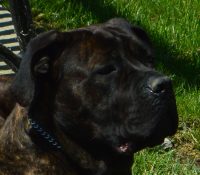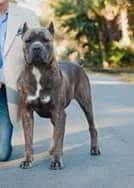 One of the dog breeds that is growing in popularity these days is the blue cane corso. It is an ancient breed that was bred to hunt big game, especially wild boar, and to provide security for its owners. It is a massive dog that these days is used mainly as a guard dog, though the breed makes an excellent family pet, as well. If you are considering this breed, there are a few things to keep in mind.
One of the dog breeds that is growing in popularity these days is the blue cane corso. It is an ancient breed that was bred to hunt big game, especially wild boar, and to provide security for its owners. It is a massive dog that these days is used mainly as a guard dog, though the breed makes an excellent family pet, as well. If you are considering this breed, there are a few things to keep in mind.
Size of the Blue Cane Corso
One crucial aspect of this breed to know is how large they are. They are mastiffs, so their bodies are large and they do take up a lot of space. They can weigh anywhere from 88 to 110 pounds, with the males coming in at the heavier end of the spectrum, and they can grow to be up to 27.5 inches tall in the shoulder area. Because of the jowls they have, these dogs also drool substantially, which is not something that every potential dog owner is comfortable with, so keep that in mind.
Temperament
The Blue cane corso is a great guard dog. They have a natural instinct to protect and are highly territorial. This can be a good thing for people who want a guard dog, but it is important to know that they need to be socialized early with other dogs and different people if you want to ensure they are not aggressive. If you have other dogs, especially, take the time to socialize the corso. These dogs make great pets for kids but they are large, so they can be clumsy and rough in their play, so they might not be the right match for people with infants. They are strong-willed animals that require a firm, confident hand, so they are probably not the right choice for people who have never owned a dog before. They are extremely sweet with their family, however, and love cuddling with their humans.
Activity Level
A Blue cane corso requires exercise, though not as much as a shepherd breed. They require stimulation, as well, or they can be destructive, and need social interactions. Having a daily training routine can be very helpful in the process of raising one of these dogs. It is a clever breed that will get into trouble if not stimulated enough. A great way to begin teaching a puppy cane corso is to require them to perform a simple command before receiving a treat or their food. This instills discipline.
Health Concerns
Like most mastiffs, the Blue cane corso has the risk of developing hip dysplasia. This is a painful condition that many large dogs get as they age, but it can be prevented by providing joint supplements throughout their lifetime. Cane corsos also tend to have bloating issues, which can cause flatulence and other problems. This can be kept in check, however, by not overfeeding or providing and providing small meals instead of one large one. The lifespan of a cane corso is 10 or 11 years, so they are about average in longevity when compared with other breeds.
When deciding on whether or not this breed is right for you and your family, keep in mind the size of the dog as well as the temperament. For people who are experienced dog owners, this can be a highly rewarding breed that is beautiful and sweet, but for beginners, this might not be the right option. Look for a reputable breeder to find healthy puppies and be sure to ask to see the parents to ensure health and purity of breed. A cane corso can be a wonderful addition to a family and can be a very loyal dog.








